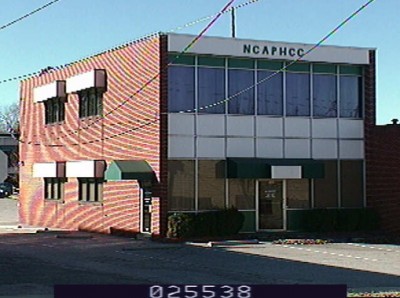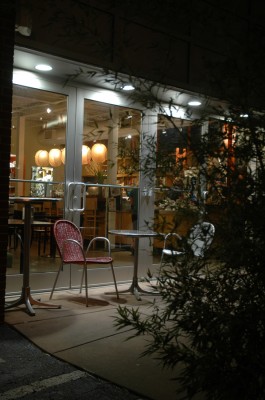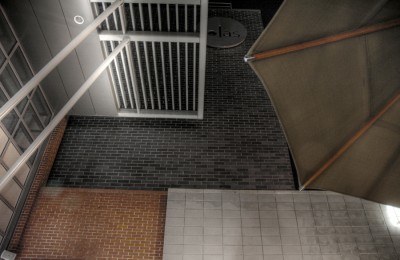Café Helios: From Plebian to Posh
The workers inside the North Carolina Association for Plumbing Heating and Cooling Control building at 413 Glenwood Ave. most likely prepared coffee that was barely strong enough to defend itself. Workers quaffed cup after cup of mediocre coffee and were just fine with it. Years later, that very same building would house Café Helios, a coffee house on Glenwood South.
Until the late 1990’s it was hard to imagine anything aside from industrial businesses thriving on south Glenwood Avenue. Before that, the street was mostly residential. Glenwood was a homely strip of road, at best. It was littered with industrial buildings that brought to mind scenes from a David Lynch film.
All of that started to change when Pine State Creamery closed in 1996 and a few restaurants popped up in the older buildings. The Rockford was one of the first, followed shortly by the Hibernian and Hard Times Cafe. In 2001, Gray Medlin bought the old Plumbing and Heating building with the intention of using the second floor as offices for his investment banking firm. After exploring several possible uses for the ground floor, he decided to open a small coffee shop. Gray wanted Helios to serve as a place where people could enjoy local coffee, art, and music. Since its opening in June of 2002, Helios has continued to serve as a social hub for Raleigh’s coffee drinkers and night owls.
Glenwood South certainly has been softened and transformed by its new tenants. The place that was once home to rough concrete and steel is now inhabited by sleek aluminum and decorative lighting schemes. I’ve always been fascinated by the unique feel exhibited by utilitarian spaces that are converted into aesthetically pleasing monuments of the past. Helios is a wonderful example of this. The terrazzo floors were undoubtedly intended to be strong and maintenance free, but when placed in a setting where functionality isn’t the foremost concern, they obtain a beauty that is often emulated but rarely convincing. The naked ceilings exposing duct work and structural details give glimpses of the buildings prior life. If you look closely on the left side of the building, you’ll notice a bricked up doorway that once led to a set of interior stairs, which incidentally now reside in Gray’s garden at his residence. I find these architectural scars very appealing as they seem to display the presence of a soul. However unassuming it may be, the building still has a soul, and that is more than many urban structures in Raleigh can claim.
Helios proudly serves Counter Culture coffee, a roastery out of Durham, and serves breakfast and lunch fare throughout the day. Six beer taps boast an insightful selection of domestic beers including several local selections complimented by a healthy selection of coffee-related spirits and a competent wine list.





 Sign up for the Newsletter
Sign up for the Newsletter
07/15/2009
There it is! Very nice indeed. Yeah, you should definitely be doing that writing thing. You’re good at it. I love Helios, probably for some of the reasons you mentioned. In a way, though, I can’t imagine it being anything other than a coffee shop. I spend so much time there, it seems like it couldn’t have possibly been anything else.
07/15/2009
Great post, thank you for sharing! Helios is my favorite coffee shop, hands down. It is cool to see the before and after.
07/15/2009
Excellent piece, and some great shots as well.
07/15/2009
Now that is just awesome Ian. I am glad to know the history of the place I work. I really enjoyed reading this. Thanks for your hard work, as always.
07/15/2009
Great stuff as always. I am really glad that you guys do this sort of thing with your blog; as someone who has only been in Raleigh since the beginning of my college days (2005) these pieces really help me learn more about the city that I love more every day.
Keep up the good work!
07/15/2009
After we moved to Boylan Heights in 2001, Dawson and I used to run wayyy up and down Glenwood all the time. Near the end of each run we’d stop and cup our hands around our faces and peer inside the building at 413 Glenwood to see the progress. We wondered what the downstairs would house….
Eight years and two kids later, Helios is still one of my favorite places in Raleigh. I’ve written a ton there, made a lot of friends, and eaten and drunk so many wonderful treats. Even today with a[nother] wriggling toddler in my arms, it’s a still place of respite, friendliness, and the best caffeine in town. Thanks to Gray and the many awesome baristas over the years for making Helios a downtown Raleigh institution!
P.S.–I miss the bluegrass evenings, tho!
07/15/2009
After we moved to Boylan Heights in 2001, Dawson and I used to run wayyy up and down Glenwood all the time. Near the end of each run we’d stop and cup our hands around our faces and peer inside the building at 413 Glenwood to see the progress. We wondered what the downstairs would house….
Eight years and two kids later, Helios is still one of my favorite places in Raleigh. I’ve written a ton there, made a lot of friends, and eaten and drunk so many wonderful treats. Even today with a[nother] wriggling toddler in my arms, it’s a still place of respite, friendliness, and the best caffeine in town. Thanks to Gray and the many awesome baristas over the years for making Helios a downtown Raleigh institution!
P.S.–I miss the bluegrass evenings, tho!
07/15/2009
Hey Ian, nice work!
I made it a point to go to Helios almost every day for a well-crafted, quality cup before I worked there. Afterwards, as you know, I had a hard time NOT going every day, and even after I had formally thrown in my barista towel, I still kept coming every day. I love that spot (but it’s mostly for the staff!)
Miss you guys!
-Seth
07/15/2009
Thanks Ian!
This is awesome. Really neat to see the “before” of where I consider my coffee spot!
Am I making it up that there was/or was supposed to be a “Six Strings” cafe upstairs?
07/15/2009
Love the history in your article, which I didn’t know. I was there tonight (and by the way, bluegrass is back!) and love the mix of people, great drinks and music and good conversation. They don’t just make good coffee but good community.
07/16/2009
Ahhh, the old stomping grounds! I miss the late hours, as all the coffee shops in Pennsylvania seem to close at 8pm, and I miss the coffee shop’s ability to serve beer and wine, as the PA laws are crazy about when and where you can sell booze.
07/28/2009
Hey Raleigh Boy,
Love this site. I have very fond memories of the NCAPHCC building. I rented the lower floor from the plumbing and heating folks during 1986-1996 before I relocated my architectural office to the old Allen Forge Building on Dawson.
Every time the legislature would consider a bill to eliminate the separate prime bidding requirements for public projects, the parking lot would fill up with Cadillacs, as the Plumbing and heating companies met to plot their strategy…..
Regards,
Kurt